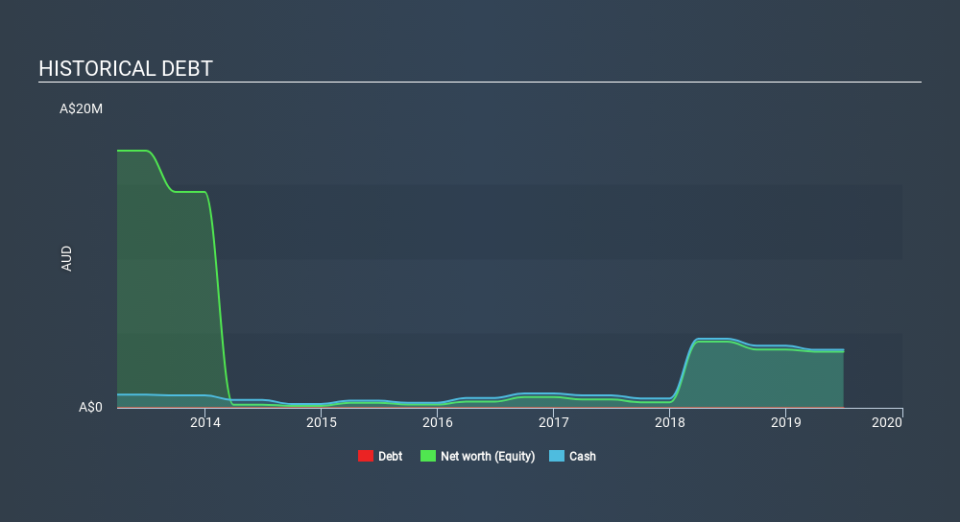Investors Who Bought Petratherm (ASX:PTR) Shares Five Years Ago Are Now Down 66%

Petratherm Limited (ASX:PTR) shareholders should be happy to see the share price up 11% in the last month. But don't envy holders -- looking back over 5 years the returns have been really bad. In fact, the share price has declined rather badly, down some 66% in that time. So we're hesitant to put much weight behind the short term increase. But it could be that the fall was overdone.
Check out our latest analysis for Petratherm
Petratherm recorded just AU$17,334 in revenue over the last twelve months, which isn't really enough for us to consider it to have a proven product. You have to wonder why venture capitalists aren't funding it. So it seems that the investors focused more on what could be, than paying attention to the current revenues (or lack thereof). For example, investors may be hoping that Petratherm finds some valuable resources, before it runs out of money.
We think companies that have neither significant revenues nor profits are pretty high risk. There is almost always a chance they will need to raise more capital, and their progress - and share price - will dictate how dilutive that is to current holders. While some companies like this go on to deliver on their plan, making good money for shareholders, many end in painful losses and eventual de-listing. Petratherm has already given some investors a taste of the bitter losses that high risk investing can cause.
When it last reported its balance sheet in June 2019, Petratherm could boast a strong position, with cash in excess of all liabilities of AU$3.5m. That allows management to focus on growing the business, and not worry too much about raising capital. But since the share price has dropped 19% per year, over 5 years , it seems like the market might have been over-excited previously. The image below shows how Petratherm's balance sheet has changed over time; if you want to see the precise values, simply click on the image. The image below shows how Petratherm's balance sheet has changed over time; if you want to see the precise values, simply click on the image.
Of course, the truth is that it is hard to value companies without much revenue or profit. Would it bother you if insiders were selling the stock? I would feel more nervous about the company if that were so. It only takes a moment for you to check whether we have identified any insider sales recently.
What about the Total Shareholder Return (TSR)?
We've already covered Petratherm's share price action, but we should also mention its total shareholder return (TSR). Arguably the TSR is a more complete return calculation because it accounts for the value of dividends (as if they were reinvested), along with the hypothetical value of any discounted capital that have been offered to shareholders. We note that Petratherm's TSR, at -56% is higher than its share price return of -66%. When you consider it hasn't been paying a dividend, this data suggests shareholders have benefitted from a spin-off, or had the opportunity to acquire attractively priced shares in a discounted capital raising.
A Different Perspective
Petratherm shareholders are up 14% for the year. But that was short of the market average. But at least that's still a gain! Over five years the TSR has been a reduction of 15% per year, over five years. So this might be a sign the business has turned its fortunes around. I find it very interesting to look at share price over the long term as a proxy for business performance. But to truly gain insight, we need to consider other information, too. To that end, you should learn about the 4 warning signs we've spotted with Petratherm (including 3 which is are significant) .
If you would prefer to check out another company -- one with potentially superior financials -- then do not miss this free list of companies that have proven they can grow earnings.
Please note, the market returns quoted in this article reflect the market weighted average returns of stocks that currently trade on AU exchanges.
If you spot an error that warrants correction, please contact the editor at editorial-team@simplywallst.com. This article by Simply Wall St is general in nature. It does not constitute a recommendation to buy or sell any stock, and does not take account of your objectives, or your financial situation. Simply Wall St has no position in the stocks mentioned.
We aim to bring you long-term focused research analysis driven by fundamental data. Note that our analysis may not factor in the latest price-sensitive company announcements or qualitative material. Thank you for reading.

 Yahoo Finance
Yahoo Finance 
